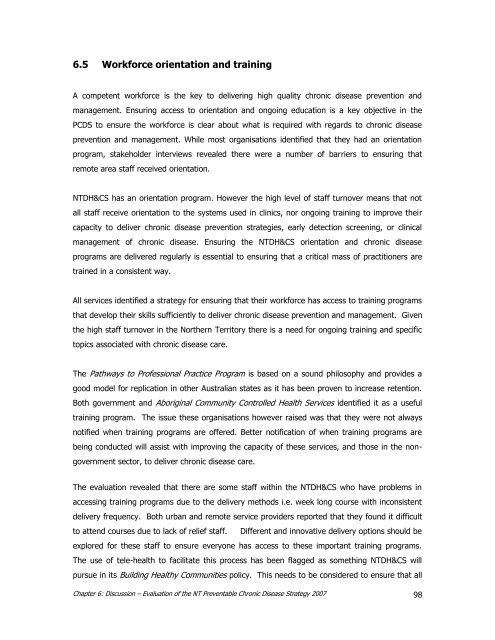PCD Strategy Evaluation 2007.pdf - NT Health Digital Library ...
PCD Strategy Evaluation 2007.pdf - NT Health Digital Library ...
PCD Strategy Evaluation 2007.pdf - NT Health Digital Library ...
You also want an ePaper? Increase the reach of your titles
YUMPU automatically turns print PDFs into web optimized ePapers that Google loves.
6.5 Workforce orientation and trainingA competent workforce is the key to delivering high quality chronic disease prevention andmanagement. Ensuring access to orientation and ongoing education is a key objective in the<strong>PCD</strong>S to ensure the workforce is clear about what is required with regards to chronic diseaseprevention and management. While most organisations identified that they had an orientationprogram, stakeholder interviews revealed there were a number of barriers to ensuring thatremote area staff received orientation.<strong>NT</strong>DH&CS has an orientation program. However the high level of staff turnover means that notall staff receive orientation to the systems used in clinics, nor ongoing training to improve theircapacity to deliver chronic disease prevention strategies, early detection screening, or clinicalmanagement of chronic disease. Ensuring the <strong>NT</strong>DH&CS orientation and chronic diseaseprograms are delivered regularly is essential to ensuring that a critical mass of practitioners aretrained in a consistent way.All services identified a strategy for ensuring that their workforce has access to training programsthat develop their skills sufficiently to deliver chronic disease prevention and management. Giventhe high staff turnover in the Northern Territory there is a need for ongoing training and specifictopics associated with chronic disease care.The Pathways to Professional Practice Program is based on a sound philosophy and provides agood model for replication in other Australian states as it has been proven to increase retention.Both government and Aboriginal Community Controlled <strong>Health</strong> Services identified it as a usefultraining program. The issue these organisations however raised was that they were not alwaysnotified when training programs are offered. Better notification of when training programs arebeing conducted will assist with improving the capacity of these services, and those in the nongovernmentsector, to deliver chronic disease care.The evaluation revealed that there are some staff within the <strong>NT</strong>DH&CS who have problems inaccessing training programs due to the delivery methods i.e. week long course with inconsistentdelivery frequency. Both urban and remote service providers reported that they found it difficultto attend courses due to lack of relief staff. Different and innovative delivery options should beexplored for these staff to ensure everyone has access to these important training programs.The use of tele-health to facilitate this process has been flagged as something <strong>NT</strong>DH&CS willpursue in its Building <strong>Health</strong>y Communities policy. This needs to be considered to ensure that allChapter 6: Discussion – <strong>Evaluation</strong> of the <strong>NT</strong> Preventable Chronic Disease <strong>Strategy</strong> 2007 98
















